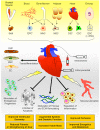Cellular Therapy for Heart Failure
- PMID: 27280304
- PMCID: PMC5011188
- DOI: 10.2174/1573403x12666160606121858
Cellular Therapy for Heart Failure
Abstract
The pathogenesis of cardiomyopathy and heart failure (HF) is underpinned by complex changes at subcellular, cellular and extracellular levels in the ventricular myocardium. For all of the gains that conventional treatments for HF have brought to mortality and morbidity, they do not adequately address the loss of cardiomyocyte numbers in the remodeling ventricle. Originally conceived to address this problem, cellular transplantation for HF has already gone through several stages of evolution over the past two decades. Various cell types and delivery routes have been implemented to positive effect in preclinical models of ischemic and nonischemic cardiomyopathy, with pleiotropic benefits observed in terms of myocardial remodeling, systolic and diastolic performance, perfusion, fibrosis, inflammation, metabolism and electrophysiology. To a large extent, these salubrious effects are now attributed to the indirect, paracrine capacity of transplanted stem cells to facilitate endogenous cardiac repair processes. Promising results have also followed in early phase human studies, although these have been relatively modest and somewhat inconsistent. This review details the preclinical and clinical evidence currently available regarding the use of pluripotent stem cells and adult-derived progenitor cells for cardiomyopathy and HF. It outlines the important lessons that have been learned to this point in time, and balances the promise of this exciting field against the key challenges and questions that still need to be addressed at all levels of research, to ensure that cell therapy realizes its full potential by adding to the armamentarium of HF management.
Figures
Similar articles
-
Stem cells in cardiac repair.Future Cardiol. 2011 Jan;7(1):99-117. doi: 10.2217/fca.10.109. Future Cardiol. 2011. PMID: 21174514 Review.
-
New directions in strategies using cell therapy for heart disease.J Mol Med (Berl). 2003 May;81(5):288-96. doi: 10.1007/s00109-003-0432-0. Epub 2003 Apr 16. J Mol Med (Berl). 2003. PMID: 12698252 Review.
-
[Myocardial regeneration with cell transplantation therapy].Nihon Geka Gakkai Zasshi. 2012 Sep;113(5):441-5. Nihon Geka Gakkai Zasshi. 2012. PMID: 23061366 Japanese.
-
Cell therapy for cardiac repair.Br Med Bull. 2010;94:65-80. doi: 10.1093/bmb/ldq005. Epub 2010 Mar 2. Br Med Bull. 2010. PMID: 20200014 Review.
-
Embryonic stem cell transplantation: promise and progress in the treatment of heart disease.BioDrugs. 2008;22(6):361-74. doi: 10.2165/0063030-200822060-00003. BioDrugs. 2008. PMID: 18998754 Review.
Cited by
-
A Survey of Unregulated Direct-to-Consumer Treatment Centers Providing Stem Cells for Patients With Heart Failure.JAMA Intern Med. 2017 Sep 1;177(9):1387-1388. doi: 10.1001/jamainternmed.2017.2988. JAMA Intern Med. 2017. PMID: 28738122 Free PMC article.
-
Stem cell therapy for non-ischemic dilated cardiomyopathy: a systematic review and meta-analysis.Syst Rev. 2024 Nov 8;13(1):276. doi: 10.1186/s13643-024-02701-2. Syst Rev. 2024. PMID: 39516841 Free PMC article.
-
Mesenchymal Stem Cells for Cardiac Regeneration: from Differentiation to Cell Delivery.Stem Cell Rev Rep. 2021 Oct;17(5):1666-1694. doi: 10.1007/s12015-021-10168-0. Epub 2021 May 5. Stem Cell Rev Rep. 2021. PMID: 33954876 Review.
-
New Treatment Strategies for Alcohol-Induced Heart Damage.Int J Mol Sci. 2016 Sep 29;17(10):1651. doi: 10.3390/ijms17101651. Int J Mol Sci. 2016. PMID: 27690014 Free PMC article. Review.
-
New Opportunities in Heart Failure with Preserved Ejection Fraction: From Bench to Bedside… and Back.Biomedicines. 2022 Dec 27;11(1):70. doi: 10.3390/biomedicines11010070. Biomedicines. 2022. PMID: 36672578 Free PMC article. Review.
References
-
- Lloyd-Jones D.M., Larson M.G., Leip E.P., et al. Lifetime risk for developing congestive heart failure: the Framingham Heart Study. Circulation. 2002;106(24):3068–3072. - PubMed
-
- Felker G.M., Thompson R.E., Hare J.M., et al. Underlying causes and long-term survival in patients with initially unexplained cardiomyopathy. N. Engl. J. Med. 2000;342(15):1077–1084. - PubMed
Publication types
MeSH terms
LinkOut - more resources
Full Text Sources
Other Literature Sources
Medical
Research Materials
Miscellaneous


